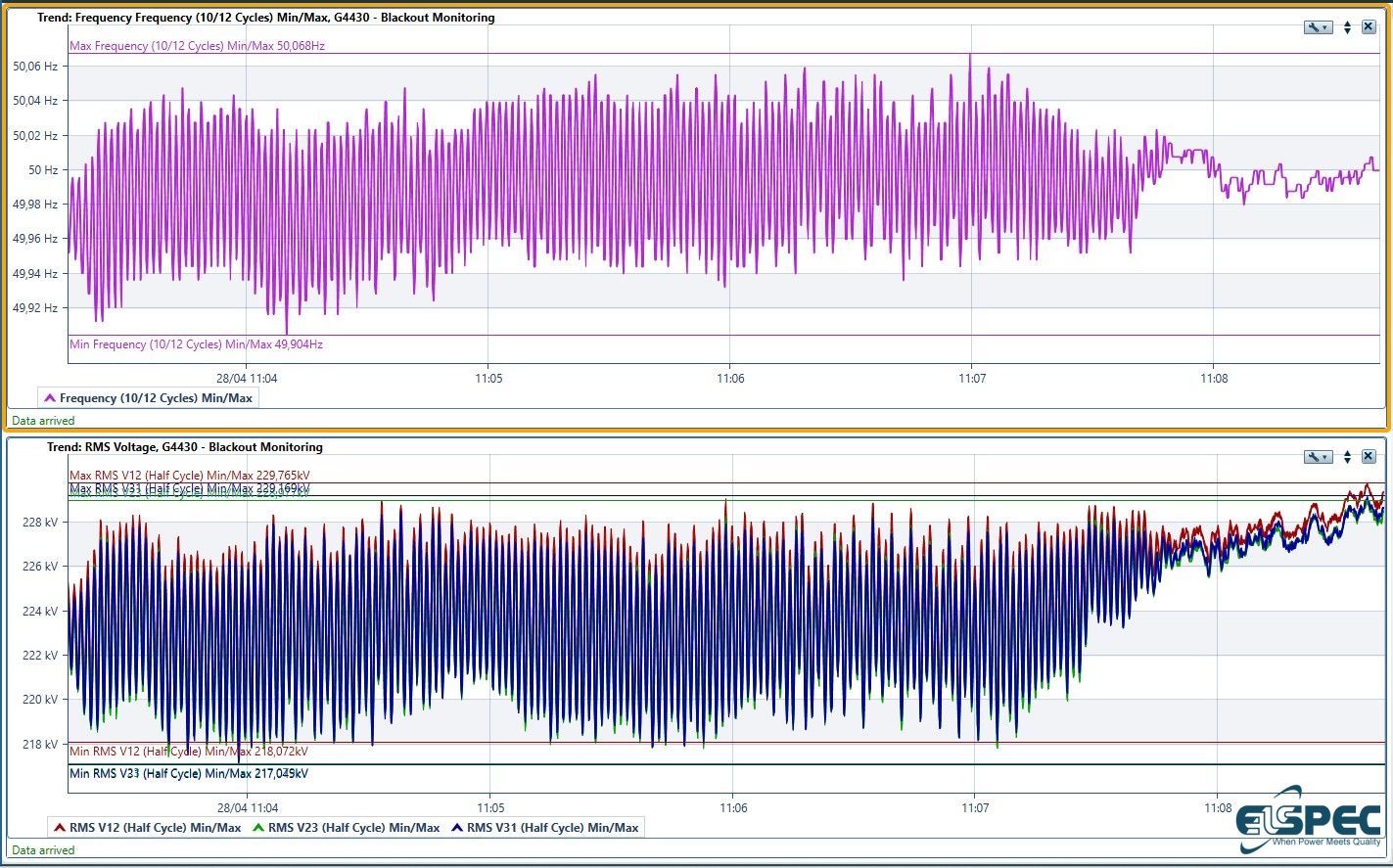The Iberian Blackout: A Wake-Up Call for UK Grid Resilience and the Role of Advanced Monitoring
On April 28, 2025, at precisely 12:33 CEST, the Iberian Peninsula plunged into darkness. A massive blackout swept across Spain and Portugal, silencing cities, halting businesses, and disrupting the lives of millions. Over 20 gigawatts of power capacity vanished in mere seconds, a loss so severe it ranks among the most significant grid failures in modern European history. The lights flickered back on within hours, thanks to the swift and coordinated efforts of the transmission system operators, but the event is a reminder of the fragility of our evolving energy systems.
As the United Kingdom accelerates its journey toward a Net Zero energy future, the lessons from this blackout resonate deeply, underscoring the critical need for advanced monitoring technologies, like those offered by Elspec, to safeguard the UK grid against similar failures.
The Iberian Blackout: The Sequence of Events
The blackout was not the result of a single, dramatic failure but a cascade of subtle, compounding issues that snowballed into a crisis. Days before the event, operators noted abnormal voltage fluctuations, faint ripples in the grid that hinted at an underlying instability. These early signs, though recorded, were not fully acted upon, as traditional monitoring systems lacked the precision to flag their severity.
By the morning of April 28, these fluctuations intensified, setting the stage for a series of critical events. At 12:03 CEST, a 0.6 Hz oscillation rippled through the grid, triggering significant voltage swings. Mitigation efforts were deployed, but they inadvertently exacerbated the problem, pushing voltage levels higher. A second, more alarming oscillation—an inter-area wave with a dominant frequency of 0.21 Hz—struck between 12:19 and 12:22, exposing the grid’s lack of damping and its vulnerability to broader instability.

Elspec’s Wide Area Monitoring Systems (WAMS) with Phasor Measurement Units (PMUs), compliant with IEEE C37.118 and IEC/IEEE 60255-118-1-2018, provided millisecond-level synchronous data, capturing these oscillations with unparalleled clarity.
By 12:32:57, the system reached its breaking point. Generation units in Granada, Badajoz, and Sevilla tripped simultaneously, wiping out 2,200 MW of capacity in an instant. This sudden loss triggered a rapid voltage spike, pushing the grid beyond its operating limits. Automatic protection mechanisms, designed to prevent catastrophic failures, kicked in, disconnecting additional generation units to protect equipment.
However, this created a vicious cycle. The loss of generation caused a plummeting frequency, which led to a loss of synchronism with France’s grid. The critical interconnection between Spain and France, a lifeline for power exchange, was severed, and the blackout spread like wildfire across the peninsula. Despite the activation of automatic load shedding and defence plans, the system collapsed entirely, leaving millions in the dark.
Probable Causes of the Blackout
The root causes of the blackout were multifaceted, revealing systemic vulnerabilities in modern power grids. The increasing reliance on renewable energy sources, particularly wind and solar, played a significant role. Unlike traditional gas or nuclear power plants, which provide inherent grid stability through their rotating mass, inverter-based renewables offer little to no inertia. This lack of inertia makes the grid more susceptible to sudden frequency fluctuations, as it lacks the natural buffer to absorb shocks from shifts in supply and demand. In the Iberian case, the rapid integration of renewables, coupled with insufficient voltage control measures, contributed to the voltage instability that set the stage for the blackout.
Limited interconnection capacity compounded the problem. Spain and Portugal’s relatively weak connections to the broader European grid restricted their ability to import power to stabilise the system during the crisis. Outdated grid management systems, reliant on legacy technologies, struggled to keep pace with the dynamic nature of a grid increasingly dominated by intermittent renewables. The absence of fast-reacting backup technologies, such as battery storage or grid-forming inverters, further limited the grid’s ability to respond swiftly to disturbances. These factors converged to create a “perfect storm,” exposing the fragility of an energy system in transition.
Relevance to the United Kingdom’s Net Zero Transition
The United Kingdom, with its ambitious Net Zero goals, faces a strikingly similar risk profile. The UK is aggressively expanding its renewable energy capacity, with wind and solar farms becoming cornerstones of its energy mix. By 2030, the government aims for 95% of electricity to come from low-carbon sources, a target that necessitates the decommissioning of traditional power plants. While the UK benefits from stronger interconnections with Europe—3 GW with France, 1 GW with Belgium, and 1 GW with the Netherlands—these alone may not suffice. The increasing penetration of renewables reduces system inertia, making the grid more vulnerable to the kinds of oscillations and voltage swings that triggered the Iberian blackout. An ageing grid infrastructure, coupled with the complexity of managing distributed energy resources, heightens the risk of a similar cascade of failures if proactive measures are not taken.
The Critical Role of Elspec Power Quality Analysers
This is where advanced monitoring technologies, like those developed by Elspec, become indispensable. The Elspec G5DFR, a cutting-edge Phasor Measurement Unit (PMU) certified under IEEE C37.118 and IEC/IEEE 60255-118-1-2018, offers a level of visibility into the grid that traditional systems simply cannot match. During the Iberian blackout, Elspec’s monitoring systems captured every waveform, every fluctuation, and every oscillation with millisecond precision, providing a detailed, real-time picture of the grid’s behaviour. Unlike Class A analysers, which offer limited snapshots, the G5DFR’s continuous, high-resolution data collection enabled engineers to reconstruct the sequence of events with unparalleled clarity. This enhanced measurement allowed for the identification of subtle anomalies—voltage variations, frequency oscillations, and waveform distortions—that signalled impending instability long before the blackout occurred.

Elspec G5 Digital Fault Recorder and Phasor Measurement Unit
The power of Elspec’s technology lies not just in its ability to record data but in how that data is used. By feeding high-frequency, high-resolution information into Wide Area Monitoring Systems (WAMS), Elspec’s PMUs enable operators to monitor voltage, frequency, and waveform behavior in real time. This allows for the early detection of patterns that could indicate trouble, such as the 0.6 Hz oscillation that marked the beginning of the Iberian crisis. With predictive analytics, these systems can forecast potential disturbances, enabling operators to take pre-emptive action, whether this is adjusting voltage set points, redistributing load, or deploying backup resources. In the UK, where the grid is undergoing a similar transformation, adopting such technologies could mean the difference between a stable system and a similar catastrophic failure.
The Iberian blackout highlighted several critical power quality issues that Elspec’s solutions are uniquely equipped to address. Voltage fluctuations, a key precursor to the collapse, can be monitored and managed with real-time data, allowing operators to implement corrective measures before they escalate. Frequency instability, driven by the low inertia of renewables, can be tracked with precision, enabling rapid response to oscillations. Harmonic distortions, often introduced by inverter-based systems, can also be detected and mitigated, ensuring the grid remains within safe operating parameters. By providing a comprehensive view of these power quality metrics, Elspec’s technology empowers operators to maintain grid stability in an era of increasing complexity.
Beyond technology, the Iberian incident underscores the need for a cultural and systemic shift. The Committee 28-A report emphasised the importance of strengthening supervision, verifying compliance, and fostering a culture of continuous improvement among stakeholders. In the UK, this translates to collaboration between network operators, regulators, and technology providers to establish clear standards and invest in grid modernisation. Upgrading infrastructure to accommodate renewables, enhancing interconnection capacity, and deploying fast-reacting backup technologies are all critical steps. However, without advanced monitoring to provide real-time visibility, these efforts risk falling short.
Conclusion
The blackout serves as a reminder that the transition to a clean energy future is not just about generating electricity but managing it intelligently. The UK’s push toward Net Zero is a monumental undertaking, but it must be accompanied by a parallel commitment to grid resilience. Technologies like Elspec’s G5DFR offer a glimpse into a new era of grid management—one where enhanced measurement, predictive analytics, and automated responses work together to prevent cascading failures. By investing in advanced metering infrastructure, distributed energy resource management systems, and micro-grids, the UK can build a grid that is not only sustainable but also robust enough to withstand the challenges of decarbonisation.
The restoration of power in Spain and Portugal was a testament to the professionalism of their network operators, who initiated black-start procedures, brought hydropower plants online, and re-established interconnections with remarkable speed. Yet, the speed of recovery does not diminish the urgency of prevention. The Iberian blackout was a wake-up call, a moment that forced the energy sector to confront the realities of a rapidly changing grid. For the UK, it is a cautionary tale that demands action. As the country races toward Net Zero, the stakes have never been higher. The lights must stay on, and technologies like Elspec’s are lighting the way to a more resilient, reliable, and sustainable energy future.
Resources
Download the Iberian Blackout Measurement Files
Download the Elspec Sapphire software (Express version)
(You can also activate a free 30-day trial of the Professional version.)
Learn more about our products and services by visiting our Power Quality Expert product catalogue, Sonel product catalogue , Electrex product catalogue or Elspec product catalogue or you can contact us to discuss your measurement requirements further.
You can also follow Power Quality Expert on LinkedIn for regular news on products, events and technical updates.
